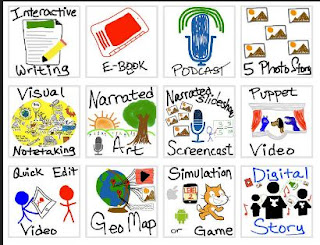Visual Literacy in the 21st Century Classroom
The 21st century educator is aware of the ever
changing trends in technology and what’s forthcoming in the future of education. They will be well rounded with career
exploration for their students and seek opportunities to prepare their students
for global competition. Therefore, 21st
century teaching strategies should encompass the same attributes. Student learning diversity is a must to
provide an educational experience that meets the needs of the world around
them. Instruction should tap into
student’s interests and abilities to help them improve their chances of success in college and beyond.
Visual literacy strategies can help students better understand
concepts as they use, create, interpret and evaluate images. Recent 21st century educational
studies estimate that we gain more than half of our knowledge through visual
texts (Krauth, 2008). Students are inundated
with multimedia on a daily basis. Visual
literacy plays a vital role in students becoming globally competitive. Therefore, it is critical that academia develop
skills in students that assist them with communicating, dissecting and creating
visual concepts that are competitive on a global scale. The Internet provides resources to extend
classroom activities. Students can
communicate beyond the walls of the classroom using media apps with other
students in different states or countries.
The Internet can be supportive in all content by providing students with
visuals, media and text that is directly linked to the intended learning (Krauth, 2008).
 |
| Visual literacy shift in the 21st century http://edtech2.boisestate.edu/jessicacassese/502/visualliteracy.html |
There are various resources available to educators that can
support visual literacy. In a 21st
century classroom educators should make sure that all visual concepts are
realistic and tangible. Students should
have a sound understanding how it relates to real-world experiences. The Internet can be used to show visual connections
on a global scale and provide students with access to gain more knowledge. Various activities such as digital
storytelling, multimedia presentations and online collaborative tools support
visual literary. I use many tech tools to help my students organize information in a visual way. This helps them store long term memory and also provides a point of reference to revisit. Students use digital resources such as Wordle to create digital word clouds for vocabulary and Voicethread tutorials to support concepts in my content (Smaldino, Lowther & Russell, 2014). The possibilities are endless when technology is supportive to
learning. Visual literacy and technology
are a great mixture to move students to higher-level thinking.
The above video provides a perspective by Zachary Nicol on how educators must produce literacy strategies that will engage our digital native students. Instructors must teach strategies for students to critically process what they are viewing and question the benefits to their needs both personally and academically.
Reference:
Krauth, K. (2008). Visual Literary: A must for the 21st
century. Retrieved March 10, 2018, from
https://ocw.mit.edu/ans7870/21f/21f.027/asia_rising/cur_teacher/ar_cur_intro.html
Smaldino, S. E., Lowther, D. L., & Russell, J. D.
(2014).
Instructional technology and media for learning (11th ed.). Upper Saddle River, NJ: Pearson/Prentice Hall. ISBN-13: 978-0133831658.
Instructional technology and media for learning (11th ed.). Upper Saddle River, NJ: Pearson/Prentice Hall. ISBN-13: 978-0133831658.
Comments
Post a Comment